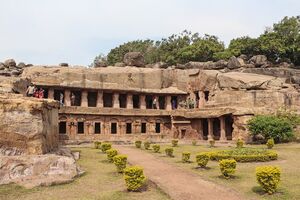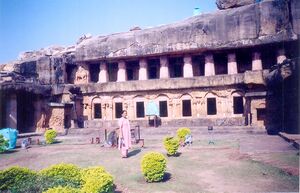Ranigumpha
| Author:Laxman Burdak, IFS (R) |


Ranigumpha (रानीगुंफा) is a cave of archaeological, historical and religious importance near the city of Bhubaneswar in Odisha, India. It is the most important of the group of caves in Udayagiri which is a double storeyed monastery. Other important caves are Hathigumpha and Ganeshagumpha.
Origin
Variants
- Ranigumpha रानीगुंफा, उड़ीसा, (AS, p.786)
- Rani gumpha रानीगुंफा
- Ranigupha (रानीगुफा)
- Rani ka Naur (Ranigumpha: Queen's Palace cave, cave-1)
History
Rani Gumpha is the largest and most popular cave among the caves of Udayagiri and Khandagiri.[1] The word 'Rani' means Queen. Although it is not an architectural marvel, it has some ancient beautiful sculptures.
This cave is double storeyed. Each storey has three wings and the central wing is bigger among all the three wings. The lower floor has seven entrances in the middle wing whereas the upper floor has nine columns. The upper portion of the central wing has relief images depicting the victory march of a king. Many of the cells have carved dwara pala images;[2] some of them are disfigured. The area that connects the central wing with right and left wings have some panels where the sculptures of wild animals, fruit-laden trees, human figures, women playing musical instruments, monkeys and playful elephants are found. The pilasters contain the toranas (arches) decorated with sculptures of Jain religious importance and royal scenes.[3]
In Udayagiri, Hathigumpha (cave 14) and Ganeshagumpha (cave 10) are especially well known due to art treasures of their sculptures and reliefs as well as due to their historical importance. Rani ka Naur (Ranigumpha: Queen's Palace cave, cave 1) is also an extensively carved cave and elaborately embellished with sculptural friezes.
रानीगुंफा, उड़ीसा
रानीगुंफा (AS, p.786): उड़ीसा में भुवनेश्वर से चार-पांच मील की दूरी पर रानीगुफा स्थित है. यह जैन गुहा मंदिरों के लिए प्रसिद्ध है. इस गुंफा या गुफा का निर्माण तीसरी सदी ईसा पूर्व में हुआ जान पड़ता है. इस गुफा में जैन तीर्थंकर पार्श्वनाथ के जीवन से संबंधित कई दृश्य मूर्तिकारी के रूप में अंकित हैं. गणेशगुफा और हाथीगुफा रानीगुफा के गुहासमूह के ही अंतर्गत हैं.[4]
खारवेल के निर्माण-कार्य
खारवेल एक महान निर्माता था। उसने राजा होते ही अपनी राजधानी को प्राचीरों तथा तोरणों से अलंकृत करवाया।अपने राज्याभिषेक के 13वें वर्ष उसने भुवनेश्वर के पास उदयगिरि तथा खंडगिरि की पहाङियों को कटवा कर जैन भिक्षुओं के आवास के लिये गुहा-विहार बनवाये थे। उदयगिरि में 19 तथा खंडगिरि में 16 गुहा विहारों का निर्माण हुआ था। उदयगिरि में रानीगुंफा तथा खंडगिरि में अनंतगुफा की गुफाओं में उत्कीर्ण रिलीफ चित्रकला की दृष्टि से उच्चकोटि के हैं। इन चित्रों में तत्कालीन समाज के जनजीवन की मनोरम झांकी सुरक्षित है। उसके द्वारा बनवाया गया महाविजय प्रसाद भी एक अत्यंत भव्य भवन था।[5]
External links
See also
References
- ↑ Allen, Margaret Prosser (1991), Ornament in Indian Architecture, University of Delaware Press, ISBN 9780874133998,p.65
- ↑ Bemmel, Helena A. van (1994), Dvarapalas in Indonesia: Temple Guardians and Acculturation, 13, CRC Press, ISBN 9789054101550,p.47
- ↑ Jāvīd, Alī; Javeed, Tabassum (2008), World Heritage Monuments and Related Edifices in India, 1, Algora Publishing, ISBN 9780875864822,pp.36-37
- ↑ Aitihasik Sthanavali by Vijayendra Kumar Mathur, p.786
- ↑ https://www.indiaolddays.com/khaaravel-ke-nirmaan-kaary/

